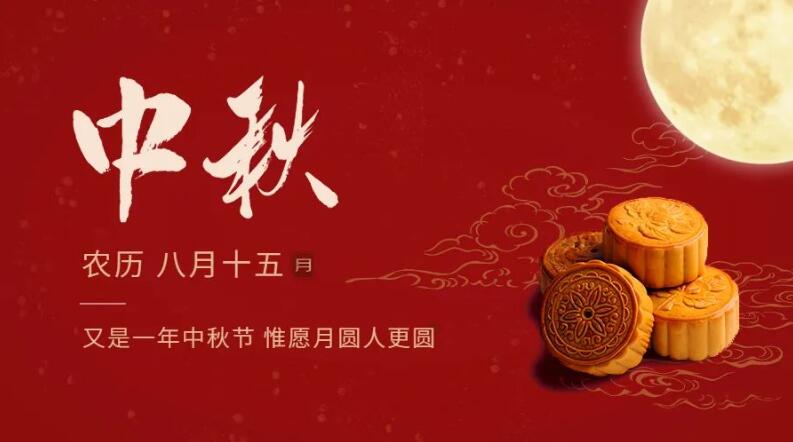Chinese Traditional Festival Mid-Autumn Festival
About the Origin of Mid-Autumn Festival
The Mid-Autumn Festival originated in China and is held on the 15th day of the eighth lunar month every year, usually from early September to early October in the Gregorian calendar. The Mid-Autumn Festival is also a traditional festival in some countries in East Asia and Southeast Asia, especially for local Chinese. The eighth month of the lunar calendar is the second month of autumn, which was called Zhongqiu or Mid-Autumn in ancient China. The Mid-Autumn Festival is not only located in the second month of the third month of autumn, but also on the 15th day of the month, which may be the reason for the name Mid-Autumn Festival. The Mid-Autumn Festival is also known as the August Festival, the Mid-Autumn Festival, the Moon Festival, the 15th Night; in Taiwan, it is also called the Autumn Festival. It is one of the four major traditional festivals of the Han nationality.

About the Mid-Autumn Festival Food
Every Chinese knows that mooncakes are eaten during the Mid-Autumn Festival, but do you know what other food customs there are during the Mid-Autumn Festival besides mooncakes? In fact, 16 kinds of delicacies such as water chestnuts, chestnuts, grapefruit, reunion steamed buns, and glutinous rice cakes are also seasonal foods during the Mid-Autumn Festival. Let's learn about the food customs of the Mid-Autumn Festival together!
1. Water chestnuts:
It is said that eating water chestnuts during the Mid-Autumn Festival can make children grow smart and clever
2. Chestnuts
Chestnuts, like taro and water chestnuts, were originally a must-eat snack during the Mid-Autumn Festival. Chestnuts are sweet and cold in nature, and have the effects of nourishing the stomach and spleen, nourishing the kidneys and strengthening the tendons.

3. Grapefruit
Because "grapefruit" and "you" are homophones, it also means hoping for the blessing of the moon. After eating sweet mooncakes, eating some sweet and sour grapefruit can both whet the appetite and relieve greasiness, leaving a refreshing feeling in the mouth.
4. Ciba
Eating ciba during the Mid-Autumn Festival originated in the Spring and Autumn Period and the Warring States Period more than 2,000 years ago. It is a traditional custom that has been passed down to commemorate Wu Zixu, a great general of the Chu State.
5. Pumpkin
During the Mid-Autumn Festival in various parts of Jiangnan, rich families eat moon cakes, while poor families have the custom of eating pumpkins. On the fifteenth day of August every year, every household in Jiangnan has the custom of eating old pumpkins and glutinous rice on the 15th day of August.
6. Lotus root
Eating lotus root during the Mid-Autumn Festival also means reunion, especially eating "lotus root boxes". People in Jiangsu and Zhejiang often cut lotus roots into slices, connect the lower ends of each two slices, and put meat, clams and other stuffing in the middle. Fry the outside until golden brown. This is also called lotus root cake, which is similar to moon cakes.
7. Crab
Autumn is also the season for crabs, which is a good time for many seafood lovers to try fresh food.

8. Snails
As for eating snails during the Mid-Autumn Festival, the "Shunde County Chronicles" during the Xianfeng period of the Qing Dynasty recorded: "On the full moon day of August, people still eat taro and snails." People believe that eating snails during the Mid-Autumn Festival can improve eyesight.
9. Taro
In Taiwan, it is also popular to eat taro during the Mid-Autumn Festival. There is a saying: "Eat rice noodles with taro, and you will have a good start." Take the homonyms of taro and road to pray for ancestors to bless you to find a good job.
10. Duck
For Nanjing people, duck is another must-eat. In terms of season, salted duck is the best around the Mid-Autumn Festival every year. This is because duck is made in the season when osmanthus flowers are in full bloom, and the duck meat will have the fragrance of osmanthus, so it is called "Osmanthus Duck".
We believe that through the above information, everyone has a certain understanding of China's Mid-Autumn Festival and food. Any food cannot be separated from the blessing of condiments. Tianjin Sino Chemical is committed to the research and development and production of various video additives. The following are our hot-selling products. If you have any needs, you are welcome to inquire at any time.
Sweetener
Acesulfame
Aspartame
Glucose/Dextrose (anhydrous/monohydrate)
Saccharin Sodium
Stevia
Sucralose
Trehalose
Maltodextrin
Thickeners
Carboxymethyl Cellulose(CMC)
Gelatin
Xanthan Gum
Agar Agar
Guar Gum
Pectin
Konjac Flour
Carrageenan
Preservatives
Sodium Benzoate
Potassium Sorbate
Calcium Propionate powder/granule/irregular particle
Sodium Metabisulfite
Sorbic Acid
Contact: Monica
whatsapp:
 Monica
Monica
Phone: +8613342014397
Tel: 022-25220868
Email: info@tjchemi.com
Add: No.180 Century Avenue, Dagang Street,Binhai New District, Tianjin, China